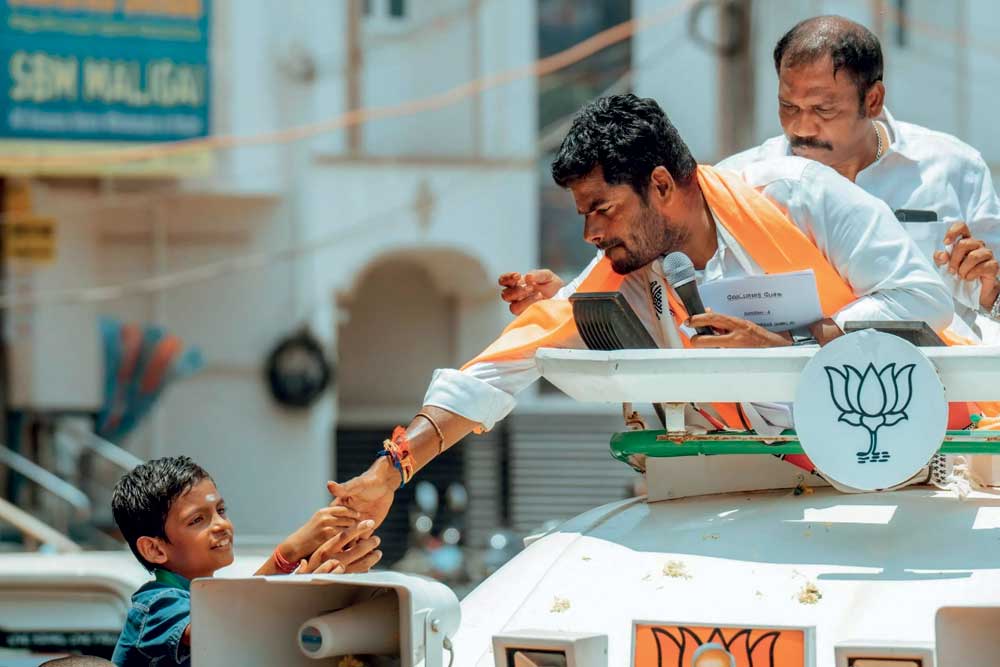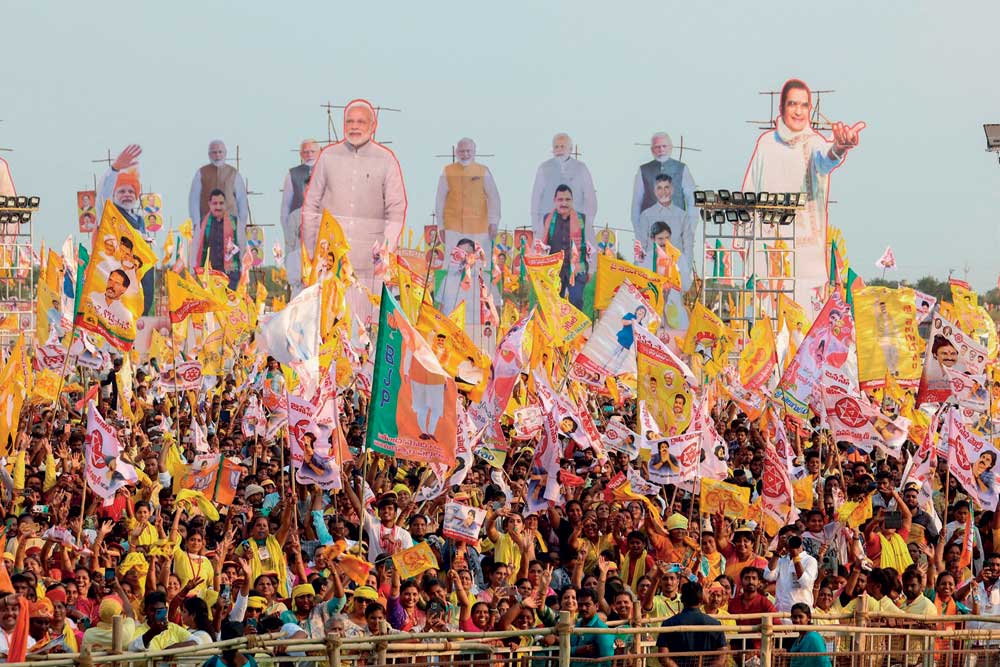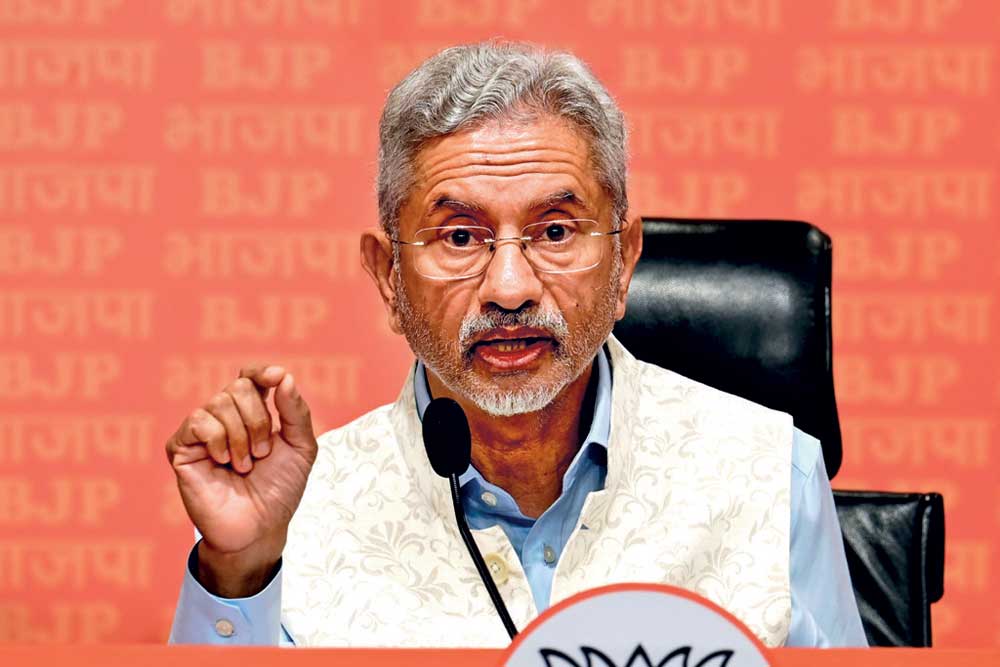Opening the Southern Front
BJP turns the Sri Lankan Island of Katchatheevu into a nationalist cause
 Rajeev Deshpande
Rajeev Deshpande
 Rajeev Deshpande
Rajeev Deshpande
 Siddharth Singh
Siddharth Singh
 |
05 Apr, 2024
|
05 Apr, 2024
/wp-content/uploads/2024/04/Southernfront1.jpg)
Prime Minister Narendra Modi attends a BJP event in Tiruppur, Tamil Nadu, February 27, 2024 (Photo: PTI)
IN THE FIRST WEEK of September 2013, the Colombo Gazette reported that the upper chamber of the Indian Parliament witnessed an “uproar” over an affidavit filed by the Congress-led United Progressive Alliance (UPA) government in the Supreme Court regarding the island of Katchatheevu which lies 33km north-east of the Indian coastline. Members from the All India Anna Dravida Munnetra Kazhagam (AIADMK), Dravida Munnetra Kazhagam (DMK), Bharatiya Janata Party (BJP), and Communist Party of India (CPI) protested vehemently, demanding the island be retrieved from Sri Lanka and the government strictly protect the rights of Tamil Nadu fishermen in the waters adjoining the island. “Katchatheevu is part of India… Entire Tamil Nadu is shocked that the UPA government in an affidavit to Supreme Court ceded it to Sri Lanka. This is the greatest betrayal to Tamil Nadu. Congress considers this country as a zamindari of the government. Congress is anti-Tamil Nadu,” AIADMK MP V Maitreyan, who had raised the issue, told the House. DMK MP Kanimozhi said Katchatheevu had been under the control of the King of Ramanathapuram (Rameswaram) and CPI’s D Raja asked the government to “re-open” the Katchatheevu agreement and renegotiate it. BJP’s M Venkaiah Naidu said the affidavit must be recalled and an all-party meeting convened to discuss the issue. The provocation for the heated scenes—UPA’s affidavit filed in response to AIADMK leader and then Tamil Nadu Chief Minister J Jayalalithaa’s writ seeking the return of the island—exemplified the perils of walking a political tightrope. In its keenness to avoid any suggestion that the Indira Gandhi government had “given away” the territory in a 1974 agreement, the affidavit asserted that nothing was ceded. “The Union government on Friday informed the Supreme Court that the question of retrieval of Kachchatheevu from Sri Lanka did not arise as no territory belonging to India was ceded to Sri Lanka,” the Hindu reported on August 31, 2013. Unsurprisingly, this set off fireworks in Rajya Sabha a few days later. Unfazed by the fact that DMK was very much a part of UPA and represented in the Union Cabinet, Kanimozhi joined other parties in asserting India’s historical claim over the island that was ceded to Sri Lanka and thereafter soon became a point of contention. The Sri Lankans made it plain that the subsequent agreement of 1976 permitted Indian fishermen only to rest and dry nets and any traditional fishing rights stood extinguished. Jayalalithaa was keenly alive to the significance of the island, protesting reports in 2016 of Sri Lanka’s plans to reconstruct the revered church of St Anthony on Katchatheevu, the site of an annual pilgrimage of devotees from India as well as Jaffna in Sri Lanka. As vital stakeholders, Indian fishing communities must be part of any plan and Colombo could not act unilaterally, she had held.
Will the Katchatheevu issue provide traction to BJP’s poll campaign? The electoral impact of the debate is likely to be felt not only in Ramanathapuram but also in nearby Thoothukudi where DMK deputy general secretary and Karunanidhi’s daughter Kanimozhi is seeking a second term
Historical fumbles have an odd way of catching up with the present. In the midst of what looks like a long and hot election, documents obtained by Tamil Nadu BJP chief K Annamalai under a Right to Information (RTI) application saw Prime Minister Narendra Modi target DMK and Congress for their “collusion” in the 1970s that led to ceding Katchatheevu to Sri Lanka and sacrificing the rights of Indian fishermen to earn their livelihood in accordance with longstanding tradition. The barb hit home. In the days that followed, Congress said Modi was trying to divert attention from an alleged Chinese land grab on the Himalayan borders and deliberately misinterpreting the terms of the agreements between then Prime Minister Indira Gandhi and Sirimavo Bandaranaike, Sri Lanka’s prime minister at the time. BJP’s criticism of DMK leaders over their dismissive and derogatory references to Sanatana Dharma did not much bother the Dravidian party. Rather, the feuding could even be seen to play to DMK’s sharpened anti- Hindutva stance. But the Katchatheevu broadside was different. It caught DMK unawares, threatening to outflank the party on its core regional identity platform. Minister of External Affairs S Jaishankar drove the point home in a media briefing on April 1, noting that he had responded to Chief Minister MK Stalin on the Katchatheevu issue and problems for Indian fishermen no fewer than 21 times. He referred in detail to archival information that DMK patriarch M Karunanidhi had been briefed of the deal with Sri Lanka and the party’s subsequent protestations were merely perfunctory. Stalin lashed out, telling election rallies that BJP was making up “stories” about the ceding of Katchatheevu island and DMK’s alleged complicity. It was evident that Jaishankar’s barb that voters needed to know “who did it and who hid it” drew blood.

Will the Katchatheevu issue sway voters in Tamil Nadu and provide traction to BJP’s poll campaign? Some commentators feel the controversy has a higher salience in the coastal belt near the island. “The continuing problem of fishing crews being detained and their boats and equipment being confiscated is a very real issue and affects many livelihoods. Even when the fishermen are released, their boats are not and this is a serious matter,” former Rajya Sabha MP and AIADMK leader V Maitreyan told Open. Smruti Pattanaik, research fellow at the Manohar Parrikar Institute for Defence Studies and Analyses, said the issue has almost entirely been a regional one and had become more pronounced after the end of the war in northern Sri Lanka. “When the war was in progress, Tamil Nadu fishermen kept away from the area. They began to enter the seas near Katchatheevu thereafter and this has led to a conflict over where exactly the maritime boundary lies,” she told Open.
The electoral impact of the debate is likely to be felt not only in Ramanathapuram, where BJP is supporting former AIADMK leader O Panneerselvam, but also in nearby Thoothukudi where DMK deputy general secretary and Karunanidhi’s daughter Kanimozhi is seeking a second term, making the contest a prestigious one for DMK. In the 2019 election, the Ramanathapuram seat was won by the Indian Union Muslim League (IUML) contestant K Navaskani. IUML is a constituent of the DMK-led alliance and Navaskani is contesting again. In 2019, BJP came second with a 32 per cent vote share against IUML’s 44 per cent. In Thoothukudi, the National Democratic Alliance (NDA) candidate is S Vijayaseelan from GK Vasan’s Tamil Maanila Congress (Moopanar). With all of Tamil Nadu’s 39 seats voting in the first phase of the Lok Sabha polls on April 19, BJP hopes to reap the benefit to the extent possible. The task is not easy, given that Thoothukudi and Ramanathapuram have sizeable minority Christian and Muslim populations that have not supported BJP in the past. Yet, many of the affected fishing communities are Christian who are increasingly vocal about their disaffection over detentions and arrests by the Sri Lankan navy.

There is a broad consensus that DMK is the frontrunner in the General Election, given its traditional vote bank and a weakened AIADMK. AIADMK’s decision not to ally with BJP has led to a competition as to who is the main challenger to DMK. As part of a coalition where AIADMK was the lead partner, BJP got close to four per cent votes in 2019. This time, the party is in alliance with four regional parties, including the Pattali Makkal Katchi (PMK), a Vanniyar-based party, with a presence in northern Tamil Nadu. Estimates vary, but the BJP alliance needs to reach a 30-35 per cent vote share that translates into seats—a tall order. Despite its decline after Jayalalithaa’s death, AIADMK is seen to retain a vote that remains loyal to the two-leaf symbol. But BJP’s calculations are not limited to Tamil Nadu alone even though the party hopes Modi’s roadshows and rallies will boost its vote share. At his rally at Rudrapur in faraway Uttarakhand on April 2, the prime minister dwelled on the circumstances that led to Katchatheevu being ceded to Sri Lanka. “Another startling example of Congress’ failures has come to the fore. The issue pertains to Tamil Nadu but people of Uttarakhand should know of Congress’ sins… If Indian fishermen even go near the island they are arrested and jailed. Can Congress, which talks of dividing the country, which gave away Katchatheevu island, protect the country?” he asked. The objective was clear enough. Katchatheevu has become part of BJP’s ‘chargesheet’ against Congress, labelling the party and its leadership as unreliable in matters relating to national security. Jaishankar had underscored the point a day earlier when he said it was the Centre that interceded every time fishermen were detained to secure their release and retrieve equipment.
Tamil Nadu Chief Minister MK Stalin has said at election rallies that BJP was making up ‘stories’ about the ceding of Katchatheevu and DMK’s complicity. It is evident that Jaishankar’s barb that voters need to know ‘who did it and who hid it’ has drawn blood
The discussion on Katchatheevu predictably led to an animated discussion on the agreement and likely fallout on relations with Sri Lanka. A section of commentators argued the agreement secured stable ties with the neighbour and delivered advantages through an exclusive economic zone that included resource-rich areas. But the argument that boundary demarcations need to be seen as a “win some, lose some” affair suffers from several infirmities. There is, for instance, no case for a comparison with the exchange of enclaves concluded with Bangladesh in 2015 which relate to, as the Ministry of External Affairs puts it, pockets along the India-Bangladesh border that have traditionally been under the possession of people of one country in the territory of another country and are known as adverse possessions. More importantly, if a territory swap or boundary demarcation leads to the resolution of a conflict or claims, it may be seen as a welcome development. The 1974 and 1976 agreements have resulted in a situation disadvantageous to India and a constant sore in the bilateral relationship. It could be argued, as some commentators have, that the agreement was concluded in “good faith” and possibly its full consequences were not evident at the time. But raking up the issue, as DMK has often done, exposes the opposition alliance as a case of selective memory or double standards—the focal point of BJP’s attack.

Despite its increased profile, BJP’s organisational network in Tamil Nadu remains a work in progress. The high-octane Katchatheevu narrative provides a window to BJP and its southern plans. It has struggled in next-door Kerala as well and there, too, the party is experimenting, importing leaders from other parties and looking to build bridges with Christian communities. In Telangana, the diminution in the fortunes of the Bharat Rashtra Samithi (BRS) offers BJP an opportunity to regain the momentum it lost ahead of last year’s Assembly polls. In Andhra Pradesh, BJP is banking on the renewed alliance with the Telugu Desam Party (TDP) and it is upbeat in Karnataka where it has allied with the Janata Dal (S).
The Katchatheevu narrative provides a window to BJP and its southern plans. The party is looking to build bridges with Christian communities in Kerala. In Andhra Pradesh, it is banking on a renewed alliance with the Telugu Desam Party and it is upbeat in Karnataka where it has allied with the Janata Dal (S)
Jaishankar sidestepped questions as to whether India would formally seek a renegotiation of the 1974 agreement, saying the matter remains in court. But the history of the island and its ownership does beg the question whether India’s claims were neglected. The story of Katchatheevu’s ownership and actual control has spanned more than 120 years. While Sri Lanka argues the island was always part of its territory based on historical records going back to the 17th century, the reality is not so simple. In the 20th century, Indian officials and fishermen from Ramanathapuram district of Tamil Nadu and adjoining areas regularly accessed the island.

Even under the terms of the 1974 boundary agreement between India and Sri Lanka—Article 5 of the agreement—Indian fishermen were to have unrestricted access to Katchatheevu. The Article says: “Subject to the foregoing, Indian fishermen and pilgrims will enjoy access to visit Kachchativu as hitherto, and will not be required by Sri Lanka to obtain travel documents or visas for these purposes.”
Jayalalithaa was alive to the significance of the island, protesting reports in 2016 of Sri Lanka’s plans to reconstruct the church of St Anthony on Katchatheevu, a site of pilgrimage for devotees from India as well as Jaffna
The first sign of conflict over the island emerged soon after Independence when the Royal Indian Navy, as the Indian Navy was then known, informed the government of Ceylon about its plan to hold exercises on the island. The exercises were not held after the Ceylon government insisted its prior permission was necessary for that purpose. Interestingly, in 1955 when the Royal Ceylon Air Force wanted to carry out gunnery practices on Katchatheevu, it informed Indian authorities via its civil aviation counterparts. The Indian case for claiming the island, apart from historical claims, is based on its customs and excise officials exercising continuous and complete jurisdiction over Katchatheevu. These officials visited the island in 1963, 1964, 1965 and 1968. Survey teams also visited the island and stationed equipment there. In the official record of the talks between Foreign Secretary Kewal Singh and then Tamil Nadu Chief Minister Karunanidhi in Madras on June 19, 1974, it was noted: “[I]n the exercise of jurisdictions through visits by customs/excise officials survey teams, there was no interference from the authorities in Ceylon. For instance, in conducting triangulation operations (1874-76), at no stage did the Government of India approach the Ceylon Government for permission or for sharing the cost of operations in Kachchativu.” It is interesting to note that the first reaction against this survey came only in 1910 when the Ceylon government requested removal of survey equipment.

This was over and above the historical claim and control by the Raja of Ramanad—as Ramanathapuram was known then—over the island. The raja was given Katchatheevu by the East India Company in 1803. Until about 1960, Indian legal and historical opinion veered towards India’s sovereignty over the island. The central fact is that—despite arguments about titles, sanads and maps—India had actual control of the island. In the end, legally, the case was lost for the proverbial want of a nail. And the real damage was due to political reasons. Prime Minister Jawaharlal Nehru found frequent questions in Parliament irksome and made his “displeasure” known to then Foreign Secretary YD Gundevia. Nehru said, “I attach no importance at all to this little island and I would have no hesitation in giving up our claim to it. I do not like matters like this pending indefinitely and being raised again and again in Parliament.” These observations by Nehru on May 10, 1961 were recorded by Gundevia in his note on the subject. Thereafter, official opinion in India—first under Nehru’s influence and later under Indira Gandhi’s—decisively favoured handing Katchatheevu to Sri Lanka.
S Jaishankar used archival information to say that DMK patriarch M Karunanidhi had been briefed of the Katchatheevu deal with Sri Lanka and the party’s subsequent protestations were perfunctory
The historical record has left two questions unexamined. First, the Katchatheevu episode is another instance of Nehru’s poor record in dealing with territorial claims and disputes, as with China over the Aksai Chin region. There are other examples as well. India did not press for its control over Kabaw Valley that had been ceded to Burma during British times. The area was part of the Kingdom of Manipur. But when India signed a treaty of friendship with Burma in 1951, that vital part of Manipur was lost forever. The second is the manner in which Katchatheevu was handled. Two agreements were signed on June 26-28, 1974 and May 10, 1976. The more consequential decision was taken during Emergency when any debate on the issue was impossible. As it turned out, there was a high cost to pay. Indian devotees wanting to attend the annual festival at the St Anthony church on the island need permission from Sri Lankan authorities to do so. This year, fishing communities in Rameswaram boycotted the festival, protesting rising instances of harassment and detention of Tamil Nadu fishermen. The fishermen alleged the Sri Lankan navy was destroying nets worth lakhs of rupees. They were particularly incensed by the sentencing of three fishermen to jail by a Sri Lanka court in February, weeks before the festival. The Tamil Guardian reported that nearly 70 fishermen were arrested in the previous two months. A thinning catch off the Tamil Nadu coast has led to Indian fishing crews venturing farther ashore where an invisible line separates territorial waters. The ceding of traditional fishing rights, along with the island itself, resulted in a double jeopardy for Tamil fishermen. BJP’s ambush has now posed hard questions for DMK and its allies.
About The Author
MOst Popular
3

/wp-content/uploads/2025/07/Cover-Shubman-Gill-1.jpg)












More Columns
Author Thomas Suárez presents peace framework for the Palestine-Israel crisis Ullekh NP
Shubhanshu Shukla Returns to Earth Open
Nimisha Priya’s Fate Hangs In Balance, As Govt Admits It Can’t Do Much Open